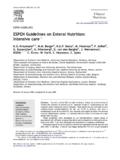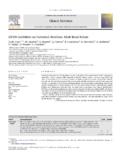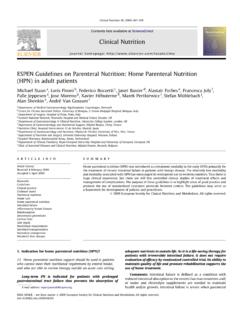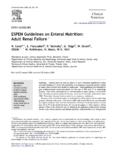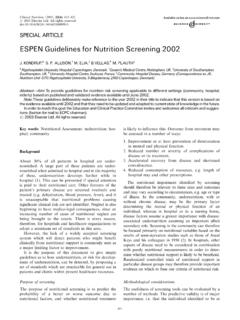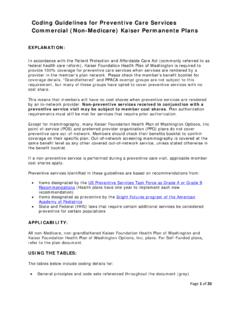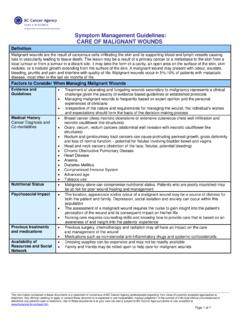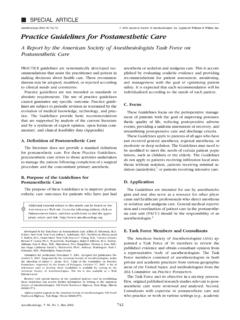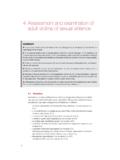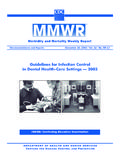Transcription of ESPEN Guidelines on Parenteral Nutrition: Intensive care
1 ESPEN Guidelines on Parenteral nutrition : Intensive carePierre Singera, Mette M. Bergerb, Greet Van den Berghec, Gianni Biolod, Philip Caldere,Alastair Forbesf, Richard Griffithsg, Georg Kreymanh, Xavier Levervei, Claude PichardjaGeneral Intensive care Department and Institute for nutrition Research, Rabin Medical Center, Beilinson Hospital, Tikva, IsraelbDepartment of Intensive care Medicine, Lausanne, SwitzerlandcKatholieke Universiteit Leuven, Leuven, BelgiumdDepartment of Clinical Morphological and Technological Sciences, University of Trieste, ItalyeInstitute of Human nutrition , School of Medicine, University of Southampton.
2 Southampton, UKfDivision of Medicine, University College London, Cleveland Street, London, UKgSchool of Clinical Sciences, University of Liverpool, Liverpool, UKhDepartment of Intensive care , University Medical Centre, Hamburg-Eppendorf, GermanyiUniversite Joseph Fourier, Grenoble Cedex 9, FrancejGeneva University Hospital, Geneva, Switzerlandarticle infoArticle history:Received 19 April 2009 Accepted 29 April 2009 Keywords:GuidelinesEvidence-basedParente ral nutritionEnteral nutritionMicronutrientsGlutamineOmega 3 fatty acidsLipid emulsionsAmino acidssummaryNutritional support in the Intensive care setting represents a challenge but it is fortunate that its deliveryand monitoring can be followed closely.
3 Enteral feeding Guidelines have shown the evidence in favor ofearly delivery and the efficacy of use of the gastrointestinal tract. Parenteral nutrition (PN) represents analternative or additional approach when other routes are not succeeding (not necessarily having failedcompletely) or when it is not possible or would be unsafe to use other routes. The main goal of PN is todeliver a nutrient mixture closely related to requirements safely and to avoid complications. Thisnutritional approach has been a subject of debate over the past carries the considerable risk of overfeeding which can be as deleterious as underfeeding.
4 Thereforethe authors will present not only the evidence available regarding the indications for PN, its imple-mentation, the energy required, its possible complementary use with enteral nutrition , but also therelative importance of the macro- and micronutrients in the formula proposed for the critically illpatient. Data on long-term survival (expressed as 6 month survival) will also be considered a relevantoutcome there is a wide range of interpretations regarding the content of PN and great diversity in itspractice, our guidance will necessarily reflect these different views.
5 The papers available are veryheterogeneous in quality and methodology (amount of calories, nutrients, proportion of nutrients,patients, etc.) and the different meta-analyses have not always taken this into account. Use of exclusivePN or complementary PN can lead to confusion, calorie targets are rarely achieved, and differentnutrients continue to be used in different proportions. The present Guidelines are the result of theanalysis of the available literature, and acknowledging these limitations, our recommendations areintentionally largely expressed as expert opinions.
6 2009 European Society for Clinical nutrition and Metabolism. All rights :PN, Parenteral nutrition . General term used to describe nutrition through either a central or peripheral venous catheter; EN, enteral nutrition . General termused to include both oral nutritional supplements (ONS) and tube feeding; ICU, Intensive care Unit; IC, Indirect calorimetry; IV, intravenous; LCT, long chain triglycerides; MCT,medium chain triglyceride; The body weight used, the body weight before acute illness in the case of fluid retention or obesity; P, phosphorus; Mg, magnesium;K, potassium; Ca, calcium; CHO, carbohydrates; PaO2/FiO2, ratio of arterial to inspired oxygen; GPX, glutathione peroxidases; EPA, eicosapentanoic acid.
7 DHA, docosahexanoic lists available atScienceDirectClinical Nutritionjournal homepage: $ see front matter 2009 European Society for Clinical nutrition and Metabolism. All rights nutrition 28 (2009) 387 4001. Should we use Parenteral nutrition (PN)? When should westart PN?Recommendation: Patients should be fed because starvationor underfeeding in ICU patients is associated with increasedmorbidity and mortality. Grade :The ICU patient skchance of survival withoutnutritional support is unknown but the increased metabolic needsrelated to stress are likely to accelerate the development of mal- nutrition , a condition associated with impaired clinical outcome.
8 Ina randomized study, 300 patients undergoing major surgeryreceived continuous total PN or exclusively glucose (250 300 g/d)intravenous administration for 14 days. Those on PN had 10 nutrition (EN), Simpson and Doig2evaluated 9 trials withcomplete follow-up and found a mortality benefit in favor of PNcompared with delayed but not early initiation of EN. Despite anassociation with increased infectious complications, a grade Bevidence-based recommendation could be generated for PN use inpatients in whom EN cannot be initiated within 24 h of ICUadmission or injury.
9 Giner et shown that nutritionaltherapy favorably influences morbidity and mortality rates incritically ill patients. In a prospective study involving 129 ICUpatients, they found that 43% were malnourished. The incidence ofcomplications (p< ), and the number of patients who failedto be discharged from hospital (p< ) were greater in themalnourished patients than in the well-nourished. In patients withless severe degrees of illness, the existence of malnutrition led toa worse outcome than in otherwise sicker clinical outcome of 48 ICU patients was analyzed for theduration of mechanical ventilation, of ICU stay, and energy deficit after 7 days and that accumulatedduring the ICU stay ( 12,600 10,520 kcal) correlated with bothtotal and infectious complications (p andp ,respectively).
10 The correlations were also strong with the durationof mechanical ventilation, the number of days of antibiotics, andthe length of ICU stay. Energy deficit however was not correlatedwith mortality. Villet et that there is as yet no answerto the question how long can an ICU patient been starved withoutdeleterious consequences .2. Should we wait for recovery and the ability of the patientto take normal nutrition or should we start PN in patientswho have not resumed normal intake within 10 days?Recommendation: All patients who are not expected to beon normal nutrition within 3 days should receive PN withinSummary of statements.
